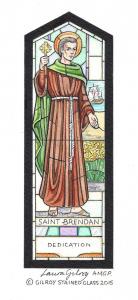20% off all products! Sale ends tonight at midnight EST.
March 15th, 2015 - 05:00 PM

This will be a particularly interesting window for us to create as Laura and I are both graduates of St. Brendan's College in Bristol before we started our apprenticeship with the studio of James, Clark & Eaton.
Our depiction shows St. Brendan as a younger man, on a mission to a new land as he was a prodigious traveller. His curragh, a wood-framed boat covered in sewn ox-hides, is pictured on the sea behind, and the foliage on the land includes daffodils as a particular favourite of the benefactor, and of course some stylized shamrocks as Brendan hailed from the land of saints and scholars.
The case that can be made for transatlantic voyages by medieval Irish monks is a reasonable one. We know that Ireland was the centre for a vigorous culture during the fifth and sixth centuries CE, preserving Christian civilization in Northern Europe after the decline and collapse of the Roman Empire. During this period Irish monks ventured out into the North Atlantic in pursuit of some kind of spiritual or divine mission. They reached the Hebrides, Orkneys, Faeroe Islands and Iceland.
St. Brendan, who was born in Ireland about 489 and founded a monastery at Clonfert, Galway, and according to legend he was in his seventies when he and 17 other monks set out on a westward voyage in a curragh. The monks sailed about the North Atlantic for seven years, according to details set down in the Navigatio Sancti Brendani Abbatis in the tenth century.
In 1976 and 1977, the adventurer Tim Severin demonstrated that such a voyage was possible by building the Brendan, a replica of a curragh, and sailing it to Newfoundland using the North Atlantic islands as stepping-stones. If Irish monks did voyage across the Atlantic and back, then their achievement was historically very significant. For Ireland was the target of Viking raids before the end of the eighth century, and is it through the Irish that the Norsemen learned about other lands further to the west?
The Norsemen did raid and eventually destroy many monasteries in Ireland, and it isn't inconceivable that historical records and art detailing these travels could have been destroyed and lost. It's always fascinated me how First Nations art here in North America and Celtic art across Europe has many similarities. An exchange of ideas and stories seems more probable than improbable to me.
Happy St. Patrick's day to everyone! We'll be fittingly painting an Irish saint, and celebrating my patron saint with a glass of Bushmills in the evening. Strictly to aid the creative juices of course.
John
Comments
There are no comments on this blog. Click here to post the first comment.